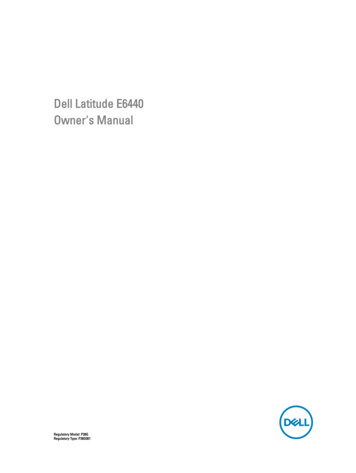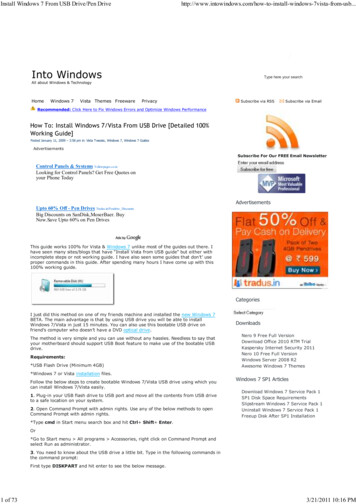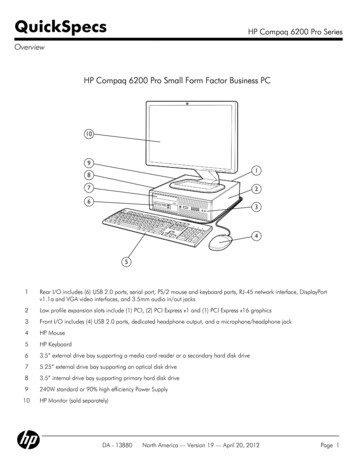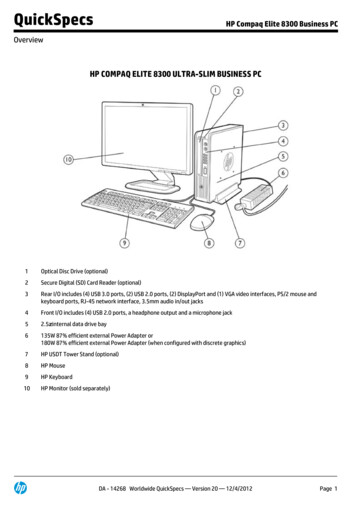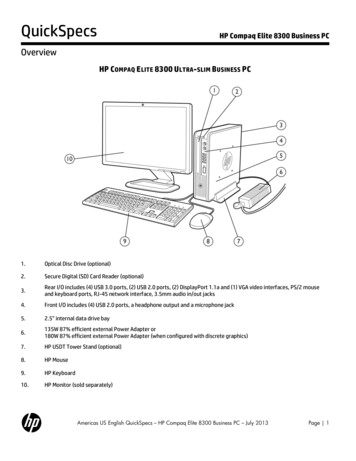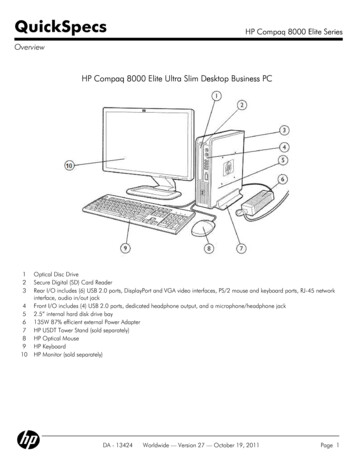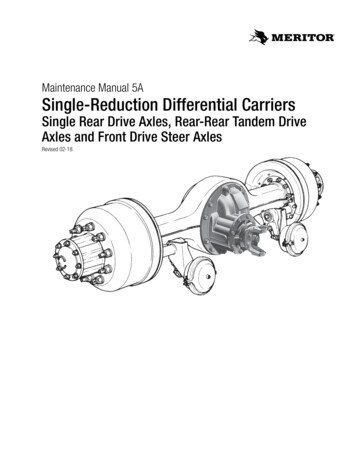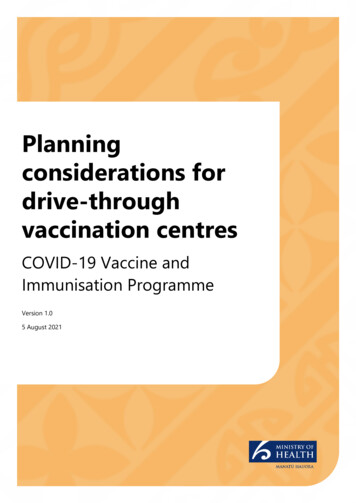
Transcription
Planningconsiderations fordrive-throughvaccination centresCOVID-19 Vaccine andImmunisation ProgrammeVersion 1.05 August 2021
Contents1.Purpose32. The drive-through service model2.1Deciding to operate a drive-through vaccination centre3. Planning considerations3353.1Site selection53.2Site set-up63.3Cold chain management83.4Clinical considerations83.5Post event considerations103.6Engagement and invitation113.7Workforce and welfare considerations114. Operating at increased Alert Levels12PLANNING CONSIDERATIONS FOR DRIVE-THROUGH VACCINATION CENTRES2
1. PurposeThis document provides guidance to District Health Boards (DHBs) and vaccination providers, tosupport planning for vaccine delivery in your community.It outlines specific considerations for using a drive-through service model to deliver thePfizer/BioNTech COVID-19 vaccine, and must be read in conjunction with: Planning considerations for community vaccination centres Operating Guidelines for DHBs & Providers (the Operating Guidelines) New Zealand COVID-19 Vaccine Immunisation Service Standards (the Service Standards) 2021 Addendum to National Standards for Vaccine Storage and Transportation Providers 2017(the National Standards for Vaccine Storage and Transportation)2. The drive-throughservice modelIn a drive-through service model, consumers go through the end-to-end vaccination processwhile in their vehicle. Drive-through vaccination centres have been used effectively in othercountries, generally in the context of minimising the spread of COVID-19 during high levels ofcommunity transmission. In New Zealand, DHBs have operated drive-through COVID-19 testingcentres (CBACs) and influenza vaccination centres during increased COVID-19 Alert Levels.Additional generic service design elements are addressed in the Ministry of Health’s Planningconsiderations for community vaccination centres guidance.2.1 Deciding to operate a drivethrough vaccination centreThis model can be used to provide safe and efficient vaccination in the event of an Alert Levelincrease, or to supplement other service models as part of the Group 4 vaccine rollout. A riskassessment and equity considerations should determine whether drive-through vaccination willbe more effective than other delivery settings.PLANNING CONSIDERATIONS FOR DRIVE-THROUGH VACCINATION CENTRES3
At Alert Levels 2 to 4 At Alert Levels 2 to 4, continuing vaccination delivery is likely to be a key strategy to reducethe risk of COVID-19 transmission in the community. Vaccination centres will need to meet physical distancing requirements, reducing the numberof vaccinations that can be administered. It is likely that a drive-through service model (whichhas inherent physical distancing) will become a more efficient option, maintaining vaccinationcapacity while providing a means to minimise COVID-19 transmission. Your contingency planning should consider whether drive-through vaccination centres will bea suitable option, including determining:– which sites could switch to provide a drive-through service– physical locations– the workforce required for safe vaccine delivery.At Alert Level 1 At Alert Level 1, it is likely to be more efficient to optimise other delivery models for thegeneral population. The drive-through service model could be used to achieve outcomes for specific populations,rather than overall programme efficiency. For example:– People in rural locations, or other areas that are heavily reliant on private vehicles.– People with limited mobility, higher sensory needs, or who prefer to be in a familiar space.– Communities that have demonstrated high acceptance of other drive-through healthservices, such as CBACs and influenza vaccination centres. Depending on your location, it may be easier to find appropriate sites for drive-throughcentres than for fixed site community vaccination centres (due to the limited availability orcost to lease indoor venues).PLANNING CONSIDERATIONS FOR DRIVE-THROUGH VACCINATION CENTRES4
3. Planning considerations3.1 Site selectionLocation considerations Is the site within a reasonable travel distance for the community you are intending to reach? Have you consulted with the community you are trying to reach, to understand and considertheir needs? Is the site close to major arterial routes or state highways? This may provide greater access. How many different routes can people use to access the site? What are the levels of traffic congestion at different times of the day?– Do your site’s opening times overlap with times of peak congestion?– Opening early or closing later may help to manage congestion. Are there any planned roadworks, road closures or events that may reduce access? Ensure potential queues will not affect access to key services, such as emergency services,health services, schools or supermarkets, or other transport routes in general. From a transport network perspective, multiple small sites are preferable to a few major sitesservicing large numbers of people. However, this needs to be balanced with the workforceand other resources required for vaccine delivery. Consult with the local council and iwi/hapū to confirm the site is appropriate. Are there any health and safety considerations that would make the site unsuitable?Site features A drive-through site must be large enough for the anticipated throughput, including adequatespace for vehicles to:– queue for registration without undue impact on other traffic.– park for at least 20 minutes during the observation period. The required space will increasein proportion to the number of vaccinators. The site should have a sealed ground surface – grass or dirt is unlikely to be suitable,particularly in wet weather. The site should have separate entry and exit points, to enable a one-way flow of traffic. If the site will also accept pedestrians, it must have appropriate entry/exit points andseparation between foot traffic and moving vehicles. There must be an on-site area (preferably a permanent structure) that can support all therequired staff facilities.PLANNING CONSIDERATIONS FOR DRIVE-THROUGH VACCINATION CENTRES5
Access to consumer and staff toilet and handwashing facilities. Any covered areas should be well-ventilated to minimise fumes from vehicles and reduce therisk of airborne COVID-19 transmission in the event of a community outbreak.3.2 Site set-upSite configuration A drive-through vaccination centre should be set up with stations for registration, consenting,vaccination, and post event observation. Ensure there is appropriate space between theseareas for vehicles to queue. The site set-up should enable private conversations when necessary. Ensure there is a quiet space for drawing up vaccine, separated from the main thoroughfare. Observation area parking should be spaced to allow all car doors to be opened, should amedical event occur. The site must be accessible by emergency services. For higher-throughput sites, provide a separate registration desk for people who haven’tbooked their vaccination. This will avoid slowing down the process for others. Determine whether the site will accept people arriving by foot, and how it will managevehicles other than cars (for example mobility scooters, or tall work vans).– Consider setting up a separate area for pedestrian registration, vaccination andobservation.– Consider triaging less straightforward vehicles to the same queue.– At all sites, it is likely that some consumers will need to exit their vehicles for vaccinationand observation (see clinical considerations below). You will need to provide appropriateseating and shelter for these consumers – the stage 2 observation area could be used ifthere isn’t a separate observation area for pedestrians. Plan how to secure equipment and pack the site down at the end of each day.PLANNING CONSIDERATIONS FOR DRIVE-THROUGH VACCINATION CENTRES6
Example site layoutFacilities It is recommended to use marquees or other cover for the registration, consent andvaccination areas, to protect people and equipment from wet weather. Ensure that marqueesare fixed with sandbags or other weights. Portable structures can be used to provide a drawing-up area and shelter for staff if existingfacilities are insufficient. Plan how you to move and store consumers’ vehicles on site, in the event they are unable todrive themselves home (for example, after fainting or receiving adrenaline). Use signage to assist with wayfinding and emphasise key instructions. Ensure that signs arelarge enough for consumers to read from their vehicles. Ensure that internet has enough range to enable use of the COVID-19 Immunisation Registerand Book My Vaccine systems in the relevant areas of the site. Consider whether generators are required to meet the site’s electricity needs. Complete a dry run before the site opens, to test the flow of vehicles and ensure staff arefamiliar with the site. If you are intending to use the drive-through model in an outbreak only, it is recommended totrial the model before it is needed – consider inviting volunteers who are not familiar with theprocess to act as consumers.PLANNING CONSIDERATIONS FOR DRIVE-THROUGH VACCINATION CENTRES7
Traffic management planning Plan how you will manage the flow of vehicles, to ensure your site operates efficiently andsafely. Consider:– the safety of staff and other pedestrians– how vehicles will arrive and leave without blocking others. Leverage existing traffic management experts to support planning and advise on anyconsiderations specific to the chosen site. They may also be able to provide trafficmanagement staff – engage through your local council or Civil Defence and EmergencyManagement (CDEM) Group. Plan how to manage a vehicle breaking down in the queue. For example, having a staff carwith jump leads on site (with at least one person knows how to use them safely). Consider how to respond to long queues and higher than expected demand, particularly ifpeople arrive without booking. For example, by checking welfare, triaging, and advisingcurrent wait times. Think about which stakeholders should be informed about your site, and how far in advance.For example:– Local authorities.– Police.– The local CDEM Group.1– Local iwi/hapū.– Community providers.– Neighbouring businesses.3.3 Cold chain managementThe existing cold chain management processes outlined in the National Standards for VaccineStorage and Transportation apply. Please follow these processes for the handling and storing ofthe vaccine at the site.Note: In a drive-through setting, extra care is required to protect the vaccine from light.3.4 Clinical considerationsYour drive-through vaccination plan must be designed and implemented with reference to theOperating Guidelines, Service Standards, and the Immunisation Handbook. Each site requires aCDEM Groups have regional transport response teams, with representatives from other relevantstakeholder groups.1PLANNING CONSIDERATIONS FOR DRIVE-THROUGH VACCINATION CENTRES8
clinical lead whose responsibilities are outlined in the Planning considerations for communityvaccination centres guidance.2The drive-through model has several practical differences to consider: At each stage of the process, ensure vehicle engines are turned off and handbrakes are on. Any person receiving the vaccine in their vehicle must be seated next to a door that can beopened.– At registration/consent, ask vehicle occupants to demonstrate that car doors can open and,ideally, that front seats can lie back.– Request that doors remain unlocked until they are ready to leave the observation area. Consumers who experienced a reaction to the first dose – and have not had a clinicaldetermination on how to proceed – must be discussed with the Clinical Lead and escalated asappropriate.3 Consider whether vaccination in drive-through setting is suitable and, if not,facilitate referral to an alternate provider. Consumers with a history of severe or immediate allergic reaction or fainting after vaccinationshould be advised via public communications to attend non-drive-through sites. If they attenda drive-through site, there needs to be an available space so that they can exit their vehiclesfor vaccination and observation. Some vehicles may seat passengers too high to be easily reached by the vaccinator. Theconsumer should exit their vehicle to be vaccinated in these cases. Where there are multiple passengers in a vehicle, the informed consent process will need tobe managed differently:– Consumers should be given the opportunity to discuss any specific concerns privately, forexample by stepping out of their vehicle. Ensure public communications prewarn peoplethat privacy is more challenging when being vaccinated with others in a vehicle.– After consent, each consumer should be given a marker such as a stamp on their hand, awristband, or sticker, to provide certainty to the vaccinator. Consider having an event ambulance or dedicated first aid team on-site – particularly for largeor remote sites.Clinical equipment Drive-through vaccination centres must have the required medical equipment and resourcesoutlined in the Operating Guidelines and Service Standards. Access to adequate resuscitationequipment and space should be identified early (for example first aid kits, adrenaline,resuscitation space, general and stage 2 observation spaces).Section 5.2: Core vaccination site roles.Refer to Immunisation Advisory Centre guidance on early and late onset adverse events followingimmunisation (AEFI).23PLANNING CONSIDERATIONS FOR DRIVE-THROUGH VACCINATION CENTRES9
Additional equipment provided for use at the site must take into consideration theaccessibility of the site to emergency services, remoteness or time delays, and the skill sets ofon-site providers. It is the responsibility of the site’s clinical lead to ensure equipment requirements are alignedwith the specifics of the site and its staffing.Clinical quality management systems and governanceClinical safety and quality requirements are sourced from the Operating Guidelines, ServiceStandards, and the Immunisation Handbook. It is expected that vaccination providers have activeclinical governance and systems in place, including an overarching Quality Lead and Clinical Lead,who have quality and safety oversight of the planning and implementation and clinicalgovernance mechanisms.Vaccination providers must submit a delivery plan to their commissioning agency that includesthe following. An overview of existing clinical quality and safety systems – at a minimum, this includesoversight of adverse events, complaints, and risk and incident management. In this context,‘adverse event’ refers not only to an AEFI, but also errors and near misses. Names and contact details – for clinical leads and quality managers, and details of the clinicalgovernance/quality and safety groups within their organisation, including frequency ofmeetings and responsibilities. Measures to address any specific issues raised by the drive-through vaccination model, suchas the procedure for moving an individual from the general observation area to the stage 2observation area if treatment of a suspected AEFI is required, and the process for referral toemergency care.3.5 Post event considerations You must ensure that observers can see the entire observation area. The number of observersrequired may increase depending on the observation area’s layout – potentially above the sitestaffing numbers recommended in the Operating Guidelines. Non-clinical observers can be used in addition to clinical post-vaccination monitoring staff. Ensure observers can efficiently alert first aiders to AEFI, or other medical events. This isparticularly relevant for large sites. Instruct consumers how to attract attention if they feel unwell – for example, by soundingtheir horns or waving. A clear emergency escalation plan must be developed with designated entry and exit lanes foremergency services. Plan how you will keep track of observation timing for each vehicle and inform consumerswhen they can leave. For example, by writing the time on the windscreen.PLANNING CONSIDERATIONS FOR DRIVE-THROUGH VACCINATION CENTRES10
When there are multiple consumers in a vehicle, the observation period should start after thefinal person has been vaccinated. The observation period could be an opportunity to offer other wrap-around health or socialservices.3.6 Engagement and invitation Open booking periods (for example a morning and afternoon slot) are recommended fordrive-through vaccination centres. Encourage people to come as a group (in line with any ‘bubble’ requirements under thecurrent Alert Level). The more consumers per vehicle, the more efficient the model is forvaccine delivery staffing. People can also keep an eye on each other during the observationperiod. As part of the invitation process, ensure that you provide information to consumers aboutwhat to expect, including:– Whether the site will accept people arriving by foot.– The requirement for each person receiving the vaccine to be seated next to a door that canbe opened.– People with a history of fainting or anaphylaxis should consider being vaccinated in a non-drive-through setting.– Recommend that people who have underlying health conditions (that might require adetailed or private conversation prior to consent) call their GP or Healthline beforeattending a drive-through vaccination, or attend a non-drive-through site.3.7 Workforce and welfareconsiderationsRoles outlined in the Planning considerations for community vaccination centres are applicable todrive-through sites. The practicalities of supervision in a drive-through setting need to be workedthrough to enable the use of COVID-19 Vaccinators as part of this model.Staff welfare Ensure staff interacting with moving vehicles wear high-vis. Provide chairs at each station for every rostered staff member. Provide shelter from the sun, wind and rain – ponchos, hats and sunscreen as appropriate.Ensure staff can easily stay hydrated.A suite of welfare resources has been developed and distributed to DHBs. These materials aim tosupport vaccination teams to be confident, calm and safe when dealing with challengingPLANNING CONSIDERATIONS FOR DRIVE-THROUGH VACCINATION CENTRES11
behaviours or when consumers are anxious. DHBs can provide access to this material to ensureproviders and vaccinators are well supported at the site.4. Operating at increasedAlert Levels Drive-through vaccination centres can be used to provide safe and effective vaccinationduring an outbreak. When operating at Alert Levels 2 to 4, your planning must consider theAlert Level-specific recommendations detailed in the Operating Guidelines and other Ministryguidance, including:– physical distancing of staff– segregation of roles– minimising staff movement between sites– consideration of staffing ‘bubbles’ for shifts– use of personal protective equipment by staff and consumers. Screening questions must be asked of staff and consumers at all Alert Levels. Where possible, avoid having the same site operate as a drive-through vaccination centre andCBAC. If a locality only has one appropriate site for drive-through services, ensure thatvaccination and CBAC areas are well-separated and that measures are in place to mitigate therisk of consumers entering the wrong queue. Staff should not be shared across services atAlert Levels 2 to 4. At Alert Levels 2 to 4, it is likely that more sites suitable for drive-through vaccination willbecome available – large event facilities will be less able to operate, and there is likely to beless traffic across the network.PLANNING CONSIDERATIONS FOR DRIVE-THROUGH VACCINATION CENTRES12
PLANNING CONSIDERATIONS FOR DRIVE-THROUGH VACCINATION CENTRES 4 At Alert Levels 2 to 4 At Alert Levels 2 to 4, continuing vaccination delivery is likely to be a key strategy to reduce the risk of COVID-19 transmission in the community. Vaccination centres will need to meet physical distancing requirements, reducing the number of vaccinations that can be administered.



